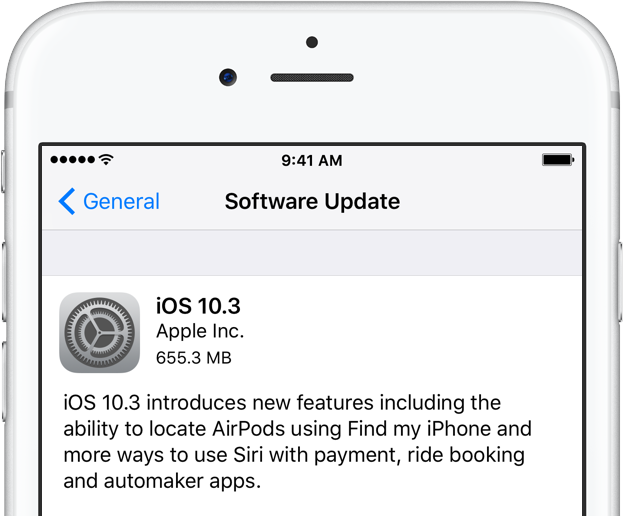Apfs Firmware Update
- Supported version: 0.6.7
Issues surrounding from initial booting the USB itself to right before you choose to boot the macOS installer
# Stuck on a black screen before picker
- Can't install using OpenCore because 'Your Mac needs a firmware update' HELP So I got over my last hurdle of 'waiting for the root device' (needed to patch HPET), and now I.
- In the Disk Utility Edit menu, select “Convert to APFS.” (It will be dimmed if you didn’t properly select the boot volume.) Disk Utility Edit Convert to APFS 5.
This is likely some error either on your firmware or OpenCore, specifically it's having troubles loading all the drivers and presenting the menu. The best way to diagnose it is via OpenCore's DEBUG Build and checking the logs whether OpenCore actually loaded, and if so what is it getting stuck on.
There are four methods to update the firmware of the UPS: Locally via a Serial or USB connection using the Firmware Upgrade Wizard application. This is the most reliable method and should be used whenever possible. Remotely via the Network Management Card (requires a Network Management Card).; Remotely via SmartConnect-compatible UPS devices (models with a 'C' suffix only – for example.
Situations where OpenCore did not load:
- If there are no logs present even after setting up the DEBUG version of OpenCore with Target set to 67, there's likely an issue either with:
- Incorrect USB Folder Structure
- See Booting OpenCore reboots to BIOS for more info
- Firmware does not support UEFI
- You'll need to setup DuetPkg, this is covered in both the macOS and Windows install pages
- Incorrect USB Folder Structure
Situations where OpenCore did load:
- Check the last line printed in your logs, there will likely be either a .efi driver that's been loaded or some form of ASSERT
- For ASSERT's, you'll want to actually inform the developers about this issue here: Acidanthera's Bugtracker(opens new window)
- For .efi drivers getting stuck, check over the following:
- HfsPlus.efi load issues:
- Try using HfsPlusLegacy.efi(opens new window) instead
- This is recommended for CPUs that do not support RDRAND, mainly relevant for 3rd gen Ivy bridge i3 and older
- VBoxHfs.efi(opens new window) is another option however is much slower than HfsPlus's version
- HiiDatabase.efi load issues:
- Likely your firmware already supports HiiDatabase, so the driver is conflicting. Simply remove the driver as you don't need it.
- HfsPlus.efi load issues:
# Stuck on no vault provided!
Turn off Vaulting in your config.plist under Misc -> Security -> Vault by setting it to:
Optional
If you have already executed the sign.command you will need to restore the OpenCore.efi file as the 256 byte RSA-2048 signature has been shoved in. Can grab a new copy of OpenCore.efi here: OpenCorePkg(opens new window)
Note: Vault and FileVault are 2 separate things, see Security and FileVault(opens new window) for more details
# Stuck on OC: Invalid Vault mode
This is likely a spelling mistake, options in OpenCore are case-sensitive so make sure you check closely, Optional is the correct way to enter it under Misc -> Security -> Vault
# Can't see macOS partitions
Main things to check:
- ScanPolicy set to
0to show all drives - Have the proper firmware drivers such as HfsPlus(Note ApfsDriverLoader shouldn't be used in 0.5.8)
- Set UnblockFsConnect to True in config.plist -> UEFI -> Quirks. Needed for some HP systems
- Set SATA Mode:
AHCIin BIOS - Set
UEFI -> APFSto see APFS based drives:- EnableJumpstart: YES
- HideVerbose: NO
- If running older versions of High Sierra(ie. 10.13.5 or older), set the following:
- MinDate:
-1 - MinVersion:
-1
- MinDate:
# Stuck on OCB: OcScanForBootEntries failure - Not Found
This is due to OpenCore being unable to find any drives with the current ScanPolicy, setting to 0 will allow all boot options to be shown
Misc -> Security -> ScanPolicy -> 0
# Stuck on OCB: failed to match a default boot option
Same fix as OCB: OcScanForBootEntries failure - Not Found, OpenCore is unable to find any drives with the current ScanPolicy, setting to 0 will allow all boot options to be shown
Misc -> Security -> ScanPolicy -> 0
# Stuck on OCB: System has no boot entries
Same fix as the above 2:
Misc -> Security -> ScanPolicy -> 0
# Stuck on OCS: No schema for DSDT, KernelAndKextPatch, RtVariable, SMBIOS, SystemParameters...
This is due to either using a Clover config with OpenCore or using a configurator such as Mackie's Clover and OpenCore configurator. You'll need to start over and make a new config or figure out all the garbage you need to remove from your config. This is why we don't support configurators, they are known for these issues
- Note: These same issues will also occur if you mix outdated configs with newer versions of OpenCore. Please update them accordingly
# Stuck on OC: Driver XXX.efi at 0 cannot be found
This is due to an entry being in your config.plist, however not present in your EFI. To resolve:
Apfs Firmware Update Windows 10
- Ensure your EFI/OC/Drivers matches up with your config.plist -> UEFI -> Drivers
- If not, please run Cmd/Ctrl+R with OpenCore to re-snapshot your config.plist
Note that the entries are case-sensitive.
# Receiving 'Failed to parse real field of type 1'
This is due to a value set as real when it's not supposed to be, generally being that Xcode converted HaltLevel by accident:
To fix, swap real for integer:
# Can't select anything in the picker
This is due to either a few things
Incompatible keyboard driver:
- Disable
PollAppleHotKeysand enableKeySupport, then remove OpenUsbKbDxe(opens new window) from your config.plist -> UEFI -> Drivers - If the above doesn't work, reverse: disable
KeySupport, then add OpenUsbKbDxe(opens new window) to your config.plist -> UEFI -> Drivers
- Disable
Missing PS2 keyboard driver(Ignore if using a USB keyboard):
- While most firmwares will include it by default, some laptops and older PCs may still need Ps2KeyboardDxe.efi(opens new window) to function correctly. Remember to add this to your config.plist as well
# SSDTs not being added
So with OpenCore, there's some extra security checks added around ACPI files, specifically that table length header must equal to the file size. This is actually the fault of iASL when you compiled the file. Example of how to find it:
The Length and checksum value is what we care about, so if our SSDT is actually 347 bytes then we want to change Length to 0x0000015B (347)(the 015B is in HEX)
Best way to actually fix this is to grab a newer copy of iASL or Acidanthera's copy of MaciASL(opens new window) and remaking the SSDT
- Note: MaciASL distributed by Rehabman are prone to ACPI corruption, please avoid it as they no longer maintain their repos

# Booting OpenCore reboots to BIOS
- Incorrect EFI folder structure, make sure all of your OC files are within an EFI folder located on your ESP(EFI system partition)
Example of folder structure
# OCABC: Incompatible OpenRuntime r4, require r10
Outdated OpenRuntime.efi, make sure BOOTx64.efi, OpenCore.efi and OpenRuntime are all from the same exact build. Anything mismatched will break booting
- Note: FwRuntimeServices has been renamed to OpenRuntime with 0.5.7 and newer
# Failed to open OpenCore image - Access Denied
On newer Microsoft Surface device firmwares, loading OpenCore will now result in a security violation even when Secure Boot is disabled. To resolve this, enable UEFI -> Quirks -> DisableSecurityPolicy in your config.plist. See here for more info: Failed to open OpenCore image - Access Denied #1446(opens new window)
# OC: Failed to find SB model disable halting on critical error
This is a typo, ensure that in your config.plist Misc -> Secuirty -> SecureBootModel is set to Disabled
Use Software Update
- Choose System Preferences from the Apple menu , then click Software Update to check for updates.
- If any updates are available, click the Update Now button to install them. Or click “More info” to see details about each update and select specific updates to install. You might be asked to enter your administrator password.
- When Software Update says that your Mac is up to date, the installed version of macOS and all of its apps are also up to date. That includes Safari, Music, Photos, Books, Messages, Mail, Calendar, and FaceTime.
- To automatically install future updates, including for apps that you got from the App Store, select “Automatically keep my Mac up to date.” Your Mac will notify you when updates require it to restart, so you can always choose to install those later.
Update the software on your iPhone, iPad, or iPod touch

Learn how to update your iPhone, iPad, or iPod touch to the latest version of iOS or iPadOS.
Learn more
Apple Apfs Firmware Update
- Learn how to get updates for earlier versions of macOS that don't include Software Update preferences.
- You can also use the App Store to update apps or redownload apps that came from the App Store.
- Learn which macOS your Mac is using and how to upgrade to the latest macOS.
- When your Mac is connected to a Personal Hotspot, large updates don't download automatically.
